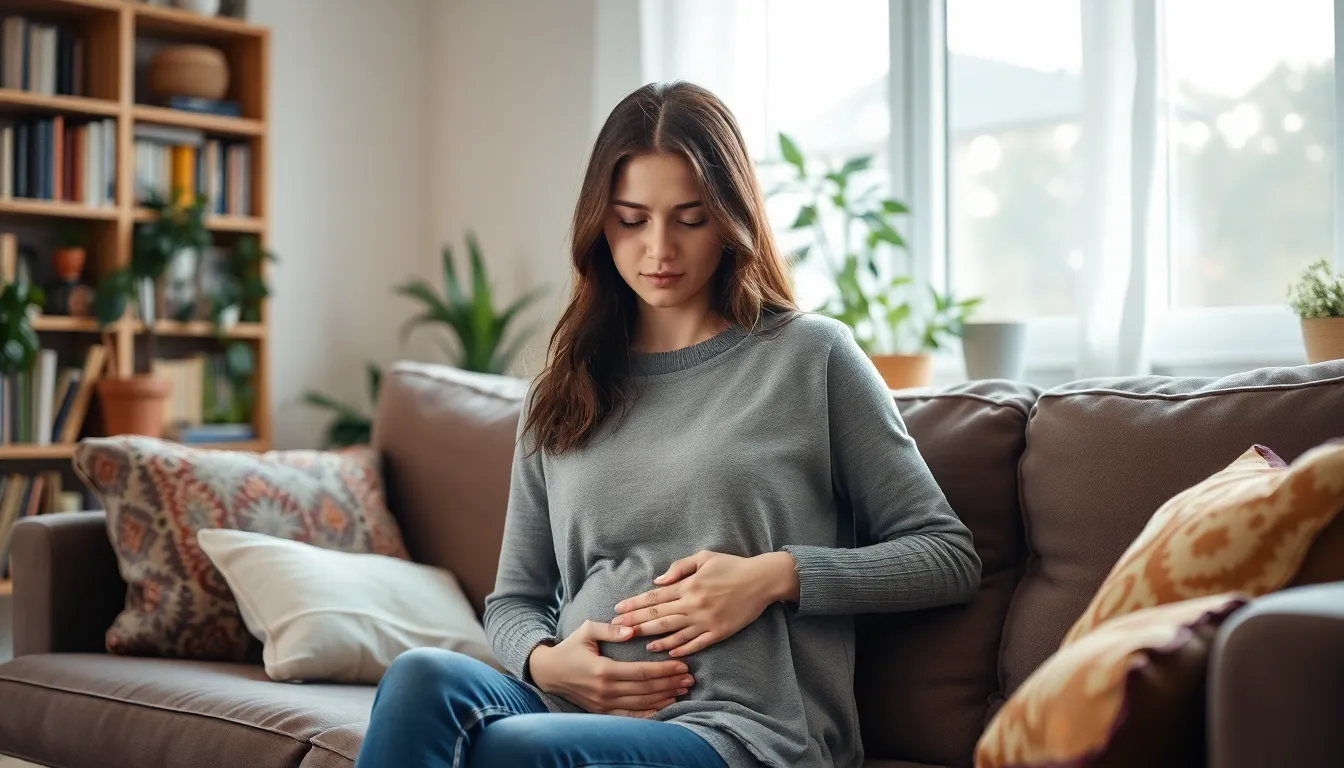Table of Contents
ToggleExperiencing cramps without a period can be puzzling and concerning, especially when pregnancy isn’t a factor. Many women find themselves in this situation, wondering what could be causing these uncomfortable sensations. Understanding the reasons behind cramps without menstruation is essential for managing one’s health effectively.
From hormonal imbalances to lifestyle factors, various conditions can lead to cramps even when a period doesn’t arrive. These symptoms often signal that the body is undergoing changes or facing challenges that need attention. By exploring potential causes, individuals can gain insights into their reproductive health and make informed decisions about seeking medical advice.
Understanding Cramps Without A Period
Cramps without a menstrual period can create confusion and concern. Understanding the nature of these cramps and their possible causes helps in managing symptoms effectively.
What Are Cramps?
Cramps are sudden, involuntary contractions of muscles, often experienced in the lower abdomen. They can vary in intensity, lasting from a few seconds to several minutes. Cramps typically occur during the menstrual cycle, but experiencing them without a period raises concerns regarding underlying health issues.
Common Causes of Cramps
Several factors may contribute to cramps when menstruation is absent:
- Hormonal Imbalances: Fluctuations in hormones like progesterone and estrogen can trigger cramps without a period. Conditions such as polycystic ovary syndrome (PCOS) can cause these imbalances.
- Stress: High levels of stress can impact hormonal regulation and may lead to muscle tension, resulting in cramps.
- Weight Changes: Significant weight loss or gain can disrupt the hormonal balance, causing cramps.
- Ovarian Cysts: Fluid-filled sacs on the ovaries can lead to discomfort and cramps even in the absence of menstruation.
- Endometriosis: This condition occurs when tissue similar to the uterine lining grows outside the uterus, causing cramps and pain.
- Gastrointestinal Issues: Digestive problems, such as irritable bowel syndrome (IBS), can cause abdominal cramps that may mimic menstrual pain.
- Pregnancy Complications: Ectopic pregnancies or miscarriages may cause cramps without a missed period, although pregnancy tests should confirm whether pregnancy is a factor.
Understanding these potential causes helps individuals identify their symptoms and consult healthcare providers for tailored advice and treatment options.
Possible Reasons for Cramps But No Period

Cramps without a menstrual period can arise from various underlying factors. Understanding these reasons can aid in identifying potential health concerns.
Hormonal Imbalances
Hormonal imbalances often lead to cramps without menstruation. Conditions like polycystic ovary syndrome (PCOS) can disrupt hormone levels, causing irregular cycles and abdominal discomfort. Additionally, fluctuations in estrogen and progesterone levels may result from other factors, such as weight gain or loss, thyroid disorders, or menopause.
Stress and Lifestyle Factors
Stress significantly affects menstrual health and may contribute to cramps. High stress levels can alter hormone production, resulting in delayed or absent periods. Lifestyle factors, including poor diet, lack of exercise, and sleep disturbances, also play a crucial role in menstrual regularity and can lead to cramping without a period.
Medical Conditions
Certain medical conditions can cause cramps while delaying menstruation. Ovarian cysts may lead to pain and irregular cycles, while endometriosis can result in significant discomfort and abnormal bleeding patterns. Gastrointestinal issues, like irritable bowel syndrome (IBS) or inflammatory bowel disease (IBD), can also mimic menstrual cramps. Seeking medical advice for persistent symptoms is essential to rule out serious conditions.
When to Seek Medical Attention
Experiencing cramps without a menstrual period can require medical evaluation. Certain warning signs indicate the need for prompt attention.
Warning Signs
- Severe Pain: If cramps become unbearable or worsen, immediate medical evaluation is essential.
- Unexplained Symptoms: Accompanying symptoms like heavy bleeding, fever, or persistent vomiting warrant urgent care.
- Long Duration: Cramps that persist for several days without improvement should be assessed by a healthcare provider.
- Previous Medical Conditions: A history of conditions like endometriosis or ovarian cysts necessitates monitoring for new symptoms.
- Changes in Cycle: Sudden changes in menstrual cycle regularity or flow may signal an underlying issue.
Potential Diagnostic Tests
- Pelvic Examination: A healthcare professional may perform a pelvic exam to check for abnormalities.
- Ultrasound: This imaging test can identify ovarian cysts or other structural issues in the reproductive system.
- Hormonal Level Testing: Blood tests can evaluate hormonal balances, such as estrogen and progesterone levels.
- Laparoscopy: In some cases, a minimally invasive surgical procedure may help diagnose conditions like endometriosis.
- Thyroid Function Tests: Assessing thyroid hormones can determine if thyroid dysfunction contributes to menstrual irregularities.
Managing Cramps Without A Period
Managing cramps in the absence of a menstrual period involves a combination of home remedies and lifestyle adjustments. These strategies help alleviate discomfort and address underlying causes effectively.
Home Remedies
- Heat Therapy: Applying heat to the abdomen can relax muscles and reduce pain. A heating pad or hot water bottle provides effective relief.
- Hydration: Drinking plenty of water helps prevent bloating and may minimize cramps. Herbal teas, such as chamomile or ginger, also have anti-inflammatory properties.
- Essential Oils: Using essential oils like lavender or peppermint for massage can provide soothing effects when applied to the abdomen.
- Nutrition: Consuming magnesium-rich foods—such as leafy greens, nuts, and seeds—may ease cramping. Additionally, incorporating anti-inflammatory foods, like berries and fatty fish, supports overall well-being.
- Rest: Prioritizing rest and relaxation techniques, such as yoga or deep breathing, can help reduce stress, which often exacerbates cramps.
Lifestyle Adjustments
- Regular Exercise: Engaging in regular physical activity improves circulation and may reduce the frequency and intensity of cramps. Activities like walking, swimming, or yoga can be beneficial.
- Balanced Diet: Following a balanced diet that includes whole grains, fruits, and vegetables can promote hormonal balance and overall reproductive health.
- Stress Management: Implementing stress-reduction practices, such as meditation, mindfulness, or counseling, can mitigate stress-induced cramps.
- Sleep Hygiene: Establishing a regular sleep schedule fosters better hormonal regulation and may decrease the occurrence of cramps.
- Limit Caffeine and Alcohol: Reducing caffeine and alcohol intake can help minimize hormonal fluctuations and discomfort associated with cramps.
Experiencing cramps without a period can be unsettling and confusing. Understanding the various factors that contribute to these symptoms is crucial for managing discomfort and maintaining reproductive health. By recognizing potential causes such as hormonal imbalances and lifestyle influences, individuals can take proactive steps to alleviate cramps.
Seeking medical advice when symptoms persist is vital to rule out serious health concerns. With the right information and strategies, individuals can navigate their symptoms effectively, ensuring they stay informed and empowered in their health journey.







